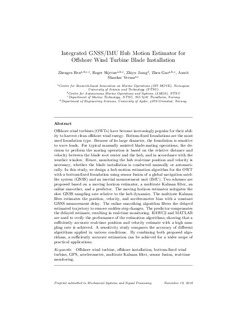| dc.contributor.author | Ren, Zhengru | |
| dc.contributor.author | Skjetne, Roger | |
| dc.contributor.author | Jiang, Zhiyu | |
| dc.contributor.author | Gao, Zhen | |
| dc.contributor.author | Verma, Amrit Shankar | |
| dc.date.accessioned | 2019-04-05T09:18:02Z | |
| dc.date.available | 2019-04-05T09:18:02Z | |
| dc.date.created | 2019-01-05T13:15:27Z | |
| dc.date.issued | 2019 | |
| dc.identifier.citation | Mechanical systems and signal processing. 2019, 123 222-243. | nb_NO |
| dc.identifier.issn | 0888-3270 | |
| dc.identifier.uri | http://hdl.handle.net/11250/2593454 | |
| dc.description.abstract | Offshore wind turbines (OWTs) have become increasingly popular for their ability to harvest clean offshore wind energy. Bottom-fixed foundations are the most used foundation type. Because of its large diameter, the foundation is sensitive to wave loads. For typical manually assisted blade-mating operations, the decision to perform the mating operation is based on the relative distance and velocity between the blade root center and the hub, and in accordance with the weather window. Hence, monitoring the hub real-time position and velocity is necessary, whether the blade installation is conducted manually or automatically. In this study, we design a hub motion estimation algorithm for the OWT with a bottom-fixed foundation using sensor fusion of a global navigation satellite system (GNSS) and an inertial measurement unit (IMU). Two schemes are proposed based on a moving horizon estimator, a multirate Kalman filter, an online smoother, and a predictor. The moving horizon estimator mitigates the slow GNSS sampling rate relative to the hub dynamics. The multirate Kalman filter estimates the position, velocity, and accelerometer bias with a constant GNSS measurement delay. The online smoothing algorithm filters the delayed estimated trajectory to remove sudden step changes. The predictor compensates the delayed estimate, resulting in real-time monitoring. HAWC2 and MATLAB are used to verify the performance of the estimation algorithms, showing that a sufficiently accurate real-time position and velocity estimate with a high sampling rate is achieved. A sensitivity study compares the accuracy of different algorithms applied in various conditions. By combining both proposed algorithms, a sufficiently accurate estimation can be achieved for a wider scope of practical applications. | nb_NO |
| dc.description.abstract | Integrated GNSS/IMU Hub Motion Estimator for Offshore Wind Turbine Blade Installation | nb_NO |
| dc.language.iso | eng | nb_NO |
| dc.publisher | Elsevier | nb_NO |
| dc.title | Integrated GNSS/IMU Hub Motion Estimator for Offshore Wind Turbine Blade Installation | nb_NO |
| dc.type | Journal article | nb_NO |
| dc.type | Peer reviewed | nb_NO |
| dc.description.version | acceptedVersion | nb_NO |
| dc.source.pagenumber | 222-243 | nb_NO |
| dc.source.volume | 123 | nb_NO |
| dc.source.journal | Mechanical systems and signal processing | nb_NO |
| dc.identifier.doi | 10.1016/j.ymssp.2019.01.008 | |
| dc.identifier.cristin | 1650965 | |
| dc.relation.project | Norges forskningsråd: 237929 | nb_NO |
| dc.relation.project | Norges forskningsråd: 223254 | nb_NO |
| dc.description.localcode | Publisher embargo until May 15, 2021 (c) This manuscript version is made available under the CC-BY-NC-ND 4.0 license http://creativecommons.org/licenses/by-nc-nd/4.0/ | nb_NO |
| cristin.unitcode | 194,64,20,0 | |
| cristin.unitname | Institutt for marin teknikk | |
| cristin.ispublished | true | |
| cristin.fulltext | postprint | |
| cristin.fulltext | original | |
| cristin.qualitycode | 1 | |
